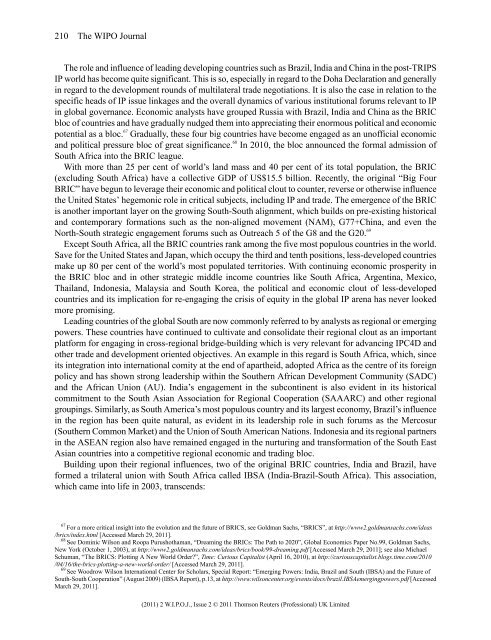WIPO Journal - World Intellectual Property Organization
WIPO Journal - World Intellectual Property Organization
WIPO Journal - World Intellectual Property Organization
Create successful ePaper yourself
Turn your PDF publications into a flip-book with our unique Google optimized e-Paper software.
210 The <strong>WIPO</strong> <strong>Journal</strong><br />
The role and influence of leading developing countries such as Brazil, India and China in the post-TRIPS<br />
IP world has become quite significant. This is so, especially in regard to the Doha Declaration and generally<br />
in regard to the development rounds of multilateral trade negotiations. It is also the case in relation to the<br />
specific heads of IP issue linkages and the overall dynamics of various institutional forums relevant to IP<br />
in global governance. Economic analysts have grouped Russia with Brazil, India and China as the BRIC<br />
bloc of countries and have gradually nudged them into appreciating their enormous political and economic<br />
potential as a bloc. 67 Gradually, these four big countries have become engaged as an unofficial economic<br />
and political pressure bloc of great significance. 68 In 2010, the bloc announced the formal admission of<br />
South Africa into the BRIC league.<br />
With more than 25 per cent of world’s land mass and 40 per cent of its total population, the BRIC<br />
(excluding South Africa) have a collective GDP of US$15.5 billion. Recently, the original “Big Four<br />
BRIC” have begun to leverage their economic and political clout to counter, reverse or otherwise influence<br />
the United States’ hegemonic role in critical subjects, including IP and trade. The emergence of the BRIC<br />
is another important layer on the growing South-South alignment, which builds on pre-existing historical<br />
and contemporary formations such as the non-aligned movement (NAM), G77+China, and even the<br />
North-South strategic engagement forums such as Outreach 5 of the G8 and the G20. 69<br />
Except South Africa, all the BRIC countries rank among the five most populous countries in the world.<br />
Save for the United States and Japan, which occupy the third and tenth positions, less-developed countries<br />
make up 80 per cent of the world’s most populated territories. With continuing economic prosperity in<br />
the BRIC bloc and in other strategic middle income countries like South Africa, Argentina, Mexico,<br />
Thailand, Indonesia, Malaysia and South Korea, the political and economic clout of less-developed<br />
countries and its implication for re-engaging the crisis of equity in the global IP arena has never looked<br />
more promising.<br />
Leading countries of the global South are now commonly referred to by analysts as regional or emerging<br />
powers. These countries have continued to cultivate and consolidate their regional clout as an important<br />
platform for engaging in cross-regional bridge-building which is very relevant for advancing IPC4D and<br />
other trade and development oriented objectives. An example in this regard is South Africa, which, since<br />
its integration into international comity at the end of apartheid, adopted Africa as the centre of its foreign<br />
policy and has shown strong leadership within the Southern African Development Community (SADC)<br />
and the African Union (AU). India’s engagement in the subcontinent is also evident in its historical<br />
commitment to the South Asian Association for Regional Cooperation (SAAARC) and other regional<br />
groupings. Similarly, as South America’s most populous country and its largest economy, Brazil’s influence<br />
in the region has been quite natural, as evident in its leadership role in such forums as the Mercosur<br />
(Southern Common Market) and the Union of South American Nations. Indonesia and its regional partners<br />
in the ASEAN region also have remained engaged in the nurturing and transformation of the South East<br />
Asian countries into a competitive regional economic and trading bloc.<br />
Building upon their regional influences, two of the original BRIC countries, India and Brazil, have<br />
formed a trilateral union with South Africa called IBSA (India-Brazil-South Africa). This association,<br />
which came into life in 2003, transcends:<br />
67<br />
For a more critical insight into the evolution and the future of BRICS, see Goldman Sachs, “BRICS”, at http://www2.goldmansachs.com/ideas<br />
/brics/index.html [Accessed March 29, 2011].<br />
68<br />
See Dominic Wilson and Roopa Purushothaman, “Dreaming the BRICs: The Path to 2020”, Global Economics Paper No.99, Goldman Sachs,<br />
New York (October 1, 2003), at http://www2.goldmansachs.com/ideas/brics/book/99-dreaming.pdf [Accessed March 29, 2011]; see also Michael<br />
Schuman, “The BRICS: Plotting A New <strong>World</strong> Order?”, Time: Curious Capitalist (April 16, 2010), at http://curiouscapitalist.blogs.time.com/2010<br />
/04/16/the-brics-plotting-a-new-world-order/ [Accessed March 29, 2011].<br />
69<br />
See Woodrow Wilson International Center for Scholars, Special Report: “Emerging Powers: India, Brazil and South (IBSA) and the Future of<br />
South-South Cooperation” (August 2009) (IBSA Report), p.13, at http://www.wilsoncenter.org/events/docs/brazil.IBSAemergingpowers.pdf [Accessed<br />
March 29, 2011].<br />
(2011) 2 W.I.P.O.J., Issue 2 © 2011 Thomson Reuters (Professional) UK Limited

















